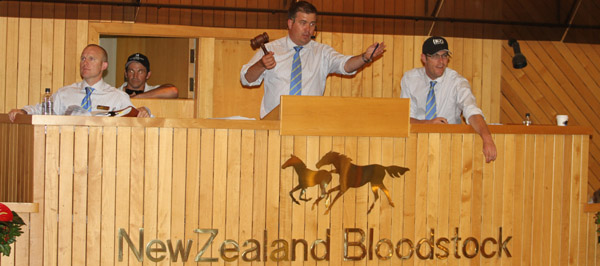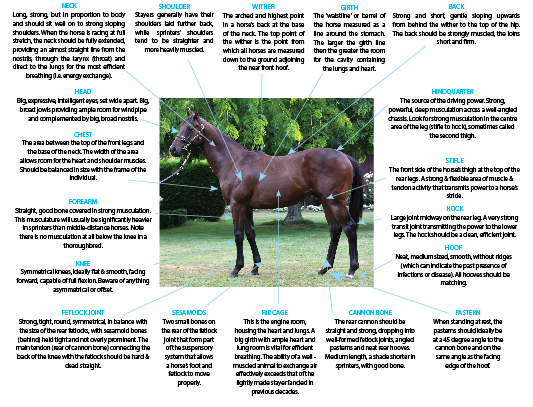Buying a racehorse
There are generally three ways to buy a horse - at auction, through private sale or by buying a share in a partnership or syndicate.
Setting your budget
When you start looking at buying a racehorse, you need to consider how much money you want to spend initially and how much you want to spend on a monthly basis. The costs of keeping a racehorse include training fees, nomination fees, vet bills, transport to and from the races, agistment when the horse is not in training, blacksmiths, gear etc. Training fees are generally between $50-$90 a day, so they can add up over the month.
If you have a lower budget, getting involved in a syndicate or partnership may be a better option as you will share the costs with the other members and only have to pay a percentage of the horse’s upkeep.
Getting expert advice before you buy
There are ownership opportunities to fit all budgets, but unless you know what you’re doing, it’s best to ask for advice from a trainer, bloodstock agent or authorised syndicator before buying a share in a racehorse, or want to buy a racehorse as the sole owner.
Using a trainer
Many trainers are experienced in selecting young horses and many will not charge a fee for helping you select and buy your new racehorse. However, in return, they will expect to train the horse for you. Trainers may also know about horses available for sale or lease, or they may have other clients with whom you could share ownership.
You can find a list of trainers at www.nztrainers.co.nz/NZTA-For-Owners/default.aspx
Using a bloodstock agent
A bloodstock agent’s main job is to find a suitable horse to fit your brief and budget. Prior to the sale, they will have researched the full list of horses available, to provide you with a shortlist of those that suit your needs. Bloodstock agents will charge either a negotiated fee or a percentage of the purchase price. A list of bloodstock agents can be found at www.bafnz.com
Using an authorised syndicator
An authorised syndicator is a recognised expert who can help you purchase a racehorse or a share in a racehorse. They’re bound by a set of rules laid down by NZTR and the Financial Markets Authority, and are required to complete a comprehensive disclosure process before syndicating any horses. This means that purchasing a racehorse with an authorised syndicator is a very transparent process.
Authorised syndicators will select an appropriate trainer, advertise and form a syndicate of members, help you to purchase a share in a horse, then communicate with you and ensure your horse is appropriately managed on a day-to-day basis. Authorised syndicators usually charge a monthly management fee.
You can find a list of authorised syndicators and their contact details here

Buying at auction
While there are a number of public auctions held each year, the key auctions for prospective racehorses at New Zealand Bloodstock are the Karaka National Yearling Sale and the Ready to Run Sale. Additionally, there are the National Online Yearling Sale, the National Weanling Sale and Gavelhouse.com online auctions, which provide fortnightly opportunities to buy a variety of horses, some of which may be viable racing prospects.
The Karaka National Yearling Sales
If you decide to purchase the racehorse of your dreams, the annual Karaka yearling sale, held in late January and early February, is an excellent place to start looking. With an average yearly foal crop of around 3500 foals, there is considerable variety and range in price for buyers. Yearlings can sell from as low as $5,500 to an all-time southern hemisphere record of $3.6 million, paid for a colt in 2000.
For more information:
Website: www.nzb.co.nz
Address: Karaka Sales Centre, 10 Hinau Road, Karaka, Papakura 2113
Telephone: +64 9 298 0055
Email: [email protected]
Ready to Run Sale
This sale is held around November for two-year-old horses who are ready to run in races. ‘Breeze ups’, where the horses are timed while performing a 200m gallop on a track, are held prior to the sale, and videos of the breeze ups are available for potential owners to view. The advantage of these sales is that your horse has already been educated and prepared, and you can see the horse’s potential under saddle before buying.
Private Sale
You can also buy a horse privately from its current owner, usually through an agent. It’s important that the horse passes a veterinary examination for racing purposes before you complete the sale.
Buying a share in a partnership or syndicate
Many trainers, authorised syndicators or bloodstock agents will have shares available in partnerships or syndicates. Information about these partnerships or syndicates can usually be found on the trainers’, authorised syndicators’ or bloodstock agents’ websites.
What to look for in a horse
There are a number of key qualities that experts look for when selecting a prospective racehorse.
Reading a pedigree
Looking at a pedigree page can be confusing, so here's a quick guide to help you understand what you should be looking for.
Decoding the Jargon
Aggregate The total gross takings of a thoroughbred sale
Bid-spotters Staff at the yearling sales placed around the sales ring to take the bids of potential buyers
Bidder Someone who intends to buy at a horse sale
Black Type A horse that wins a Group or Listed races earns “black type” i.e. this achievements will be noted in the
pedigree page in BOLD or “black” type for any progeny of this horse
Broodmare A mare used for breeding
By A term used to refer to the sire of a horse. For example, is horse is said to be “by” Zabeel if Zabeel is its
sire
Clean legs Legs that are free of swelling, deformity or conformation faults
Colt A young male horse (3 years and under)
Conformation A horse’s anatomical make-up
Dam A horse’s mother
Draft Horses presented for sale by a stud or vendor
Fetlock The leg joint that is the equivalent of the human ankle
Filly Female horse (3 years and under)
Foal A baby horse still suckling its mother
Gavel The auctioneer’s hammer
Gelding A male horse that has been castrated
Halter A bitless bridle used for leading a horse
Hand The form in which horses are measured from the ground to the top of the wither (shoulder). One
hand is equivalent to 10cm
Horse/Stallion A male horse (4 years and over) that is used or will potentially be used for breeding purposes
Knocked down The term used to describe that the horse has been sold on the fall of the auctioneer’s hammer
Lot number The thoroughbred sale catalogue number allocated to each horse
Median The middle price of the sale i.e. where 50% of the catalogue is sold for more and 50% is sold for less
Near shoulder The horse’s left shoulder is referred to as the near should as this is the shoulder nearest to the rider
when mounting on the traditional left side
Passed In If the horse has failed to reach its reserve price at auction
Pedigree The family history of a horse
Reserve price The minimum price set by the vendor for the sale of the horse at auction
Rig An abnormally developed or improperly castrated male horse
Service The mating of a mare by a stallion
Sire The horse’s father
Stud The property where the broodmare and stallion are mated
Studmaster The person in charge of the stud


